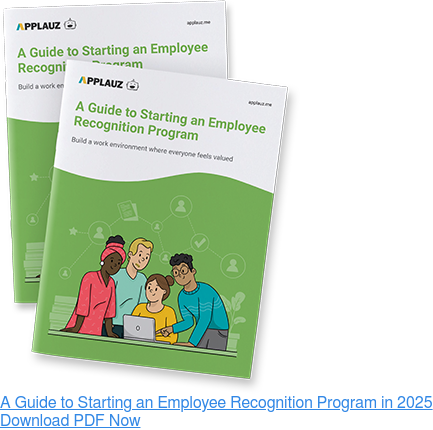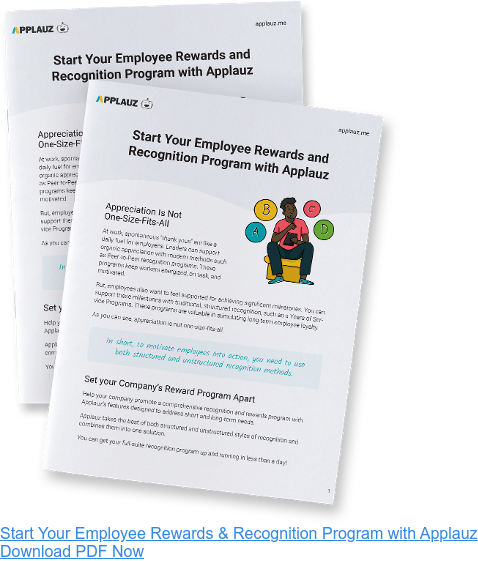For better or worse, AI is here to stay and continue to shake up various industries. In the HR world, the conversation around artificial intelligence has mainly been centered around recruiting.
For example, LinkedIn’s The Future of Recruiting 2024 report revealed that 62% of recruiting pros are optimistic about AI’s impact on their field. Moreover, according to The Society for Human Resource Management, talent acquisition is the top way for organizations that have embraced AI for HR purposes.
While jobseekers may have a different opinion, leaders and HR professionals are enthusiastic about AI adoption: 76% of HR leaders believe that if their organization does not adopt and implement AI solutions, they will be lagging behind those who do, according to Gartner.
If you’re one of them, there’s a use case that you may not have thought about yet: Leveraging AI for employee recognition. Considering that recognition has a drastic impact on engagement, retention and performance, this insight may help you stay ahead of the game.
 How AI is Changing Employee Recognition
How AI is Changing Employee Recognition
Wondering how AI can help you improve your efforts to recognize employees while avoiding the potential pitfalls of relying on technology to praise humans? Here are nine ways AI is changing employee recognition – and the dos and don’ts of using it to build a solid recognition program.
-
Personalized Employee Recognition Opportunities
In order to be effective, employee recognition needs to be personalized. Ironically, AI can help you add a personal touch to your efforts. Because it analyzes data from different sources, it can provide you with a deeper understanding of employees' individual preferences.
For example, by processing data such as performance reports, peer feedback, and shoutouts on communication channels, AI can provide information about a team member’s unique achievements.
This not only allows you to give genuine and personal praise, but it also helps you gain insight into what drives different employees. AI algorithms are even able to recommend personalized rewards based on the patterns they pick up on.
-
Communication Tools for Appreciation Messages
AI chatbots will never replace human praise. That would defeat the purpose of authentic recognition that makes employees feel valued. That said, they can help managers put together impactful employee appreciation messages.
Some people are stronger writers than others, but that shouldn’t stop anyone from sharing words of acknowledgement. A little help from AI can help a manager nail the tone and language of their recognition message based on the context and occasion.
-
Real-Time Achievement Tracking and Timely Recognition
Timely recognition is crucial to the success of your employee recognition strategy. According to Gallup, 40% of employees report only receiving recognition a few times a year or less. Meanwhile, when recognition is effective, team members are five times more likely to be connected to company culture and four times more likely to be engaged. Delivering recognition frequently and recognizing achievements as they happen is crucial.
AI tools can help track achievements in real time. For example, they can flag the moment a team member meets their sales target and send you a notification. They can also notify you when projects are completed. This takes the guesswork out of identifying and rewarding accomplishments as they happen – not months later when an employee has already started to disengage from failing to be recognized for their win.
-
Ensuring Fairness and Reducing Bias in Recognition
DEI (Diversity, Equity and Inclusion) is a top-of-mind concern for HR leaders. Employee recognition strategies can foster diversity by celebrating employees of all backgrounds and levels. The opposite is also true: Unfair recognition practices create unhealthy, imbalanced cultures.
When programmed well and supervised by humans, AI can help reduce biases and ensure fairness and inclusivity in recognition efforts. The idea is to use objective data to acknowledge employees while highlighting opportunities to recognize team members fairly at all levels of the organization.
-
More Efficient Recognition Systems
Let’s face it: Automation is a godsend when it comes to eliminating tedious work and focusing on more impactful tasks. AI can help reduce the administrative burden that HR teams face so they can invest more in what matters most: optimizing their employee recognition strategies and making people feel valued.
For example, AI can automatically deploy an employee survey and compile the findings for you every few weeks to help you assess how well your recognition strategy is working. Or it can automate the process of shipping employee birthday gifts. The possibilities are endless.
-
Better Analytics and Performance-Tracking
AI tools can process large amounts of data quickly, which makes them incredible for analytics and performance tracking. So, how do you use artificial intelligence’s advanced reporting capabilities to your advantage for employee recognition?
By setting up AI to measure the effectiveness of your employee recognition program. For example, you can access detailed analytics reports to understand how different types of recognition affect engagement, productivity and retention. This way, you can optimize your strategies based on data instead of guesses.
AI can even perform sentiment analysis on qualitative feedback. If you’re running employee surveys and getting both hard metrics and written answers, an AI tool can analyze the written answers to give you insights into morale and identify areas where recognition may be lacking.
-
Predicting and Preventing Employee Disengagement
Insights are one thing, but they’re pointless if you’re not using them to take action. AI can predict and prevent employee disengagement trends over time. As a leader, you can then take measures to curtail those patterns. For example, you may notice that despite your best efforts to recognize employees, your engagement rate has been slightly dropping in the past few months.
You ask your team about the type of rewards and recognition that they would value the most and find out that they’re not included in your current strategies. You take steps accordingly and manage to increase the engagement rate through your efforts. Thanks to AI, you’ve successfully managed to retain top talent.
-
Showing Appreciation Through Career Development
Career development opportunities can be a powerful way to reward employees. According to Zippia, 45% of employees would remain at a company longer if it invested in their learning and development, while a staggering 92% of workers say that employee training programs have a positive impact on their engagement when they’re planned well.
AI can help you make sure that career development is well-planned. How? By identifying team members’ strengths and ambitions based on their past achievements and recognition history. This provides you with a plan that you can use to work on a personalized path with top performers eager to grow.
-
Gamification of Employee Recognition Programs
Gamifying your employee recognition program can encourage adoption and foster a culture of gratitude and appreciation. Thanks to AI, you don’t have to reinvent the wheel and come up with crazy new concepts to turn employee appreciation into a fun endeavour. There are plenty of tools that offer you the ability to create leaderboards, friendly challenges, and custom rewards.
AI is also great for maximizing communication channels and internal social platforms. It can create automated feeds to share achievements or encourage peer-to-peer recognition through smart nudges.
 Potential Downsides of Using AI to Recognize Employees
Potential Downsides of Using AI to Recognize Employees
As you see, AI can bring a host of benefits to employee recognition strategies. On the other hand, it’s important to be aware of its potential downsides before adopting it blindly.
Privacy is one of the most significant concerns to consider. AI systems rely on data, which means they need to access personal and professional information to function properly. This can raise ethical concerns and even make some team members uncomfortable.
It’s also important to keep the humanity in HR. The last thing you want is for team members to feel dehumanized like they’re being assessed by a machine and given templatized recognition instead of receiving genuine appreciation from their peers or boss. This would make your recognition efforts more harmful than helpful and undermine the sense of belonging and connection within your team.
Another potential challenge tied to AI and employee recognition is the importance of accurate data and algorithms. When it’s programmed well, AI can help you maximize the potential of employee recognition. But if it’s using incorrect data, AI can lead to unfair recognition practices and perpetuate inequalities instead of mitigating them. Carefully designing and updating your systems remains imperative.
Furthermore, there is always a risk of overrelying on technology. Managers have a responsibility to recognize employees and engage with them. They may inadvertently let those efforts slide with AI in the mix, which can be harmful to their culture.
That said, you shouldn’t be scared of using AI for employee recognition. There are so many clever employee recognition-related applications to play with. But being mindful is crucial.
Aim to balance AI's efficiency with a human touch to harness its full potential.
.jpg?width=800&height=540&name=view-automatic-recognition-software-analyzing-everyday-subjects-entities%20(1).jpg) The Dos and Don’ts of Using AI for Employee Recognition
The Dos and Don’ts of Using AI for Employee Recognition
If you’re interested in using artificial intelligence for employee recognition so you can boost morale, improve engagement and streamline your processes, here are some dos and don’ts to keep in mind.
Ensure Transparency
Before, during and after the implementation of AI tools for employee recognition, keep the communication lines open with your team. Be transparent about how the new systems are going to work, what kind of data they are going to rely on and how recognition decisions will be made.
Personalize Recognition
Leverage AI to personalize recognition as much as possible. Successful employee appreciation efforts are tailored ones. So, use all the insights at your disposal to highlight specific achievements and contributions – and adapt the type of recognition to individual preferences.
Integrate Human Oversight
Managers and HR leaders need to review all your new AI-generated tools and systems and validate decisions. Technology should be a supplement to human judgment but it should never replace it.
Consider Data Privacy and Security
Consider data privacy and security in your plans. Consult with experts as needed and implement solid data protection measures to protect confidential information. Again, be transparent with employees about the data being collected and how it’s going to be used.
Use AI to Identify Recognition Opportunities
AI can detect patterns and identify milestones and opportunities to recognize team members. Set up automatic reminders to make the most of these moments and give timely recognition.
Leverage AI to Encourage a Culture of Recognition
Encourage a culture of recognition through the use of AI tools. Instead of limiting employee appreciation to formal occasions, lean on artificial intelligence to create daily habits around different types of recognition. Encourage peer-to-peer recognition, enhance the features of your communication channels and social platforms, and gamify your efforts for the best results.
Don’t Rely Solely on AI
Never depend entirely on artificial intelligence for processes related to human beings. AI may be super powerful, but it can miss out on important nuances and context. Balance its insights with a good dose of human empathy and judgment.
Don’t Overlook Algorithm Biases
Stay aware of the fact that algorithms can have dangerous biases. Regularly audit and refine your systems to keep them fair and inclusive – and don’t hesitate to solicit employee feedback as you do so.
Don’t Make Recognition Robotic
Recognition must feel authentic and meaningful to be effective. Don’t make it so systematic that it becomes robotic. Complement AI tools with personal, human efforts such as face-to-face shoutouts and handwritten notes. Also, make sure any automation reflects your organizational values and culture.
Don’t Monitor Employees Excessively
Avoid making people feel excessively monitored through the use of AI. The focus should always be positive reinforcement and appreciation – not oversight that feels intrusive and breaks trust.
As technology evolves, it’s normal – and healthy – for HR practices to follow suit. From maximizing your ability to celebrate achievements in real-time to delivering in-depth insights that will make your strategies smarter, AI is changing employee recognition in positive ways.
If you keep its potential pitfalls in mind, adopting it can benefit your culture and help you appreciate employees. Have fun experimenting with multiple use cases, adapt them to your culture – and always keep timeless employee recognition best practices in mind.
Finally, since leveraging technology can be so helpful for recognizing employees, consider using best-in-class employee recognition software like Applauz. This tool automates many of your employee recognition efforts while being fully customizable to your culture.
About the author
Anouare Abdou
Anouare Abdou is a seasoned HR and business writer passionate about leadership, productivity, and the future of work. Her words have appeared in Business Insider, The Ladders, Thrive Global and more.




